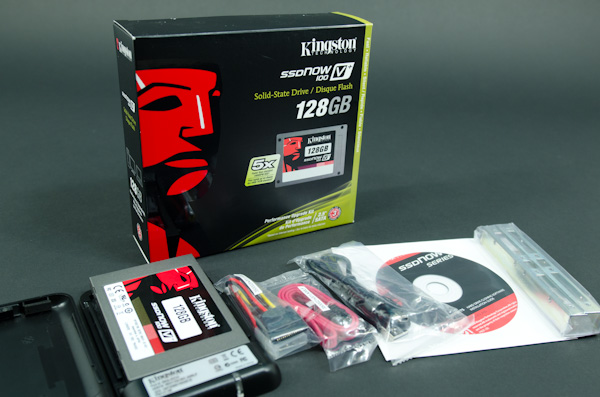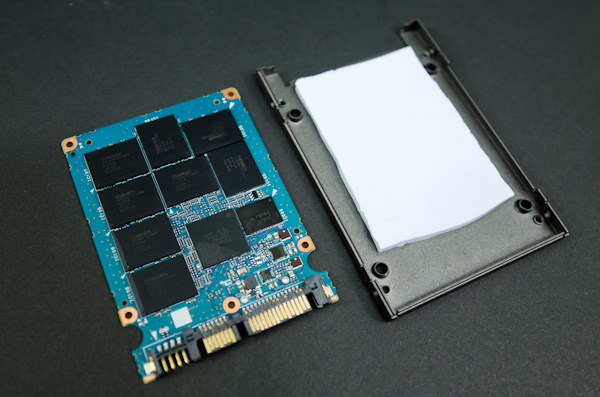Kingston SSDNow V+100 Review
by Anand Lal Shimpi on November 11, 2010 3:05 AM EST- Posted in
- Storage
- SSDs
- Kingston
- SSDNow V+100
Final Words
Kingston, like many of its competitors, desperately needs a simplified product lineup. On the one hand, Kingston has hedged its bets. With three different controller makers supplying hardware for its six SSDs, Kingston can't go wrong. However, the Toshiba powered SSDNow V+ spans the gamut from mediocre random write speed to chart topping performance in some of our workloads. The real world test results are strong enough for me to recommend the drive, however two things don't sit well with me.
First is the price. The V+100 commands a nearly $50 premium over competing SandForce drives. While I can understand paying some premium for Toshiba's name and hopefully reliability, that's a bit much. Compared to the RealSSD C300 the premium is negligible, so the complaint only applies as long as SandForce is in the running.

Kingston sells SSDs as both standalone drives or a part of an upgrade kit
The second issue is the overly aggressive garbage collection. Sequential performance on the V+100 just doesn't change regardless of how much fragmentation you throw at the drive. The drive is quick to clean and keeps performance high as long as it has the free space to do so. This is great for delivering consistent performance, however it doesn't come for free. I am curious to see how the aggressive garbage collection impacts drive lifespan. Kingston ships the V+100 with a 3-year warranty and to Kingston's credit I haven't had any other drives die as a result of wearing out the NAND. Even if the V+100 has higher effective write amplification than the competition, your usage model will determine whether or not you bump into it.
Toshiba is clearly close to knocking this one out of the park. There's a tangible improvement over the original V+ and the drive is clearly doing some things right. The V+100 isn't flawless, but it's finally in the list of drives to consider.
SandForce continues to be the sensible choice, at least in terms of performance per dollar for a boot/application drive. I am careful to mention it as a boot/application drive because if you start storing a lot of incompressible data on the drive (e.g. movies, music, photos) then SandForce quickly loses a lot of its performance advantage. Then you're left with Crucial's RealSSD C300 which delivers more consistent performance regardless of data, at the expense of lower steady state write performance. Without TRIM, the C300 can quickly get into a not-so-great performance situation.
If you don't want a SandForce drive and are running an OS without TRIM support, the V+100 is probably a better option than the C300 thanks to its aggressive garbage collection. I realize this isn't the simplest recommendation, but that's the reality of today's SSD market. There are a lot of great options, but nothing is absolutely perfect.











96 Comments
View All Comments
Ezekeel - Thursday, December 9, 2010 - link
That is all you have to do to enable TRIM, yes.However, I was talking about optimizations for an SSD (https://wiki.archlinux.org/index.php/SSD#Tips_for_... http://cptl.org/wp/index.php/2010/03/30/tuning-sol... which you all have to do manually while Windows7 afaik does at least some optimizations automatically if you install it on an SSD, like disabling (Super)PreFetch and indexing. Also partition setup with diskpart under Windows automatically takes care of a proper partition alignment while you still have to do it manually under Linux (http://randomtechoutburst.blogspot.com/2010/03/4k-...
ClagMaster - Monday, November 15, 2010 - link
You are right Mr Shimpi that this is confusing and I got a headache.I am not certain what I am going to get if I order a Kingston Drive. Performance is so diverse and the model nomenclature so similar.
I am going to get a OCZVertex 2 or an Intel X-25 G2 instead. I know what I am getting with these brands.
psyside1 - Sunday, November 21, 2010 - link
Hi Anand and all who read this.
Let me start of by saying that i'm new to SSD tech (noob) and i'm starting to learning but there are some things which where not pointed in the reviews as far as i remember.
Heck, even in this review you said that Inferno is somewhat capped to 50 mb/s if i'm not wrong?
So in short,
Where i live i'm limited to 2 models, one is Patriot Inferno and the Other A-DATA S599 with possibly 50K IOPS firmware, as Newegg and Amazon specs confirm?
Now, does that firmware insure i won't get slowdowns (at some points) like the Inferno model in this review? or there is some more about it. if there is, i really got no idea how is that possible same controller, same build? and heck in most of the test the Vertex 2 is still fastest, even faster then the other drives which now share the 50K IOPS firmware, G.Skill Phoenix pro, Corsair Force etc??
i'm mostly interested in SSD which will have good read/write speeds (4K etc) and to be fast during programs/games installation. I got 6 pcs connected in network so that means alot to me, in short does my needs require higher IOPS firmware or i would not notice any difference in performance during installation of big size programs/games.
Also, is it possible to know what revision you get without actually buying the product? is there any info on the package/sticker or part number? the difference in performance i noticed in some reviews was 2x higher random write (4K) speed on the models with OCZ "exclusive firmware. And as far that point goes i'm totally clueless does it really matter at all, and if its not how that that translate in real world usage?
Please answer i don't want to regret my purchase :(
Thanks and sorry for slight off topic :)
psyside1 - Sunday, November 21, 2010 - link
Sorry for double post there is no edit option, actually Madman007 was asking the same i did on the more appropriate way, my English is bad.
tno - Sunday, May 1, 2011 - link
"Remember that NAND is written to at the page level (4KB), but erased at the block level (512 pages)." I think you meant '512 KB.'Gaucherre - Friday, May 6, 2011 - link
Instead of $259, the Kingston V100+ 96GB is available for $119.99 after rebate from Buy.com. This pricing completely changes the value rating from acceptable to outstanding value! The mail-in rebate is rotating from one online store to another. Last month it was at Newegg.com; right now it's at Buy.com. Next month - who knows? Anyway, the cost per Gigabyte when tested here at Anandtech.com was around $2.70. Now it's $1.25 per Gigabyte, and a 96GB drive is large enough for Windows plus quite a few installed programs and games. Pretty good value. Think I just talked myself into ordering one .......